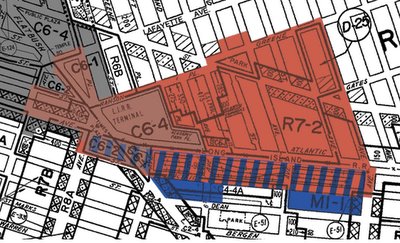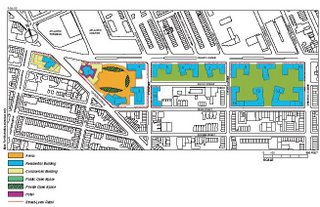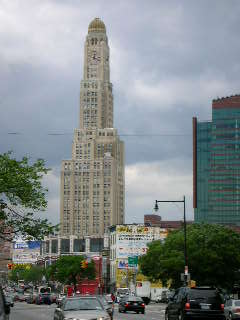 Daily News columnist Errol Louis (right), a stalwart defender of the Atlantic Yards project, went on the Brian Lehrer Live TV show Wednesday, and for about five minutes of the segment, responded to critics and opponents of the plan, including some issues I raised the week before.
Daily News columnist Errol Louis (right), a stalwart defender of the Atlantic Yards project, went on the Brian Lehrer Live TV show Wednesday, and for about five minutes of the segment, responded to critics and opponents of the plan, including some issues I raised the week before.I'll discuss his remarks below, but one surprising conclusion emerges. Louis defended the scale of the Atlantic Yards project by citing the nearby presence of the city's tallest public housing tower. But his citation doesn't so much endorse Atlantic Yards as support a significant reduction in density. Why? Even that tower contains fewer than half the number of apartments per acre as the current Atlantic Yards plan proposes.
Getting to the brochure
At about 10:58 of the show, Lehrer's interview with Louis turned to the Atlantic Yards issue.
BL: Last week on the show we had an opponent of the Atlantic Yards project in Brooklyn, which I believe you support, the arena for the Nets and the 16 high-rise apartment and office buildings. Our discussion revolved mostly around the scale, how immense it is compared to the neighborhood, and the brochure, a promotional flier, and sent to thousands of people in Brooklyn, promoting the idea that, my guest said was “extremely deceptive.” I want to show you why this brochure was described as deceptive, and get your reactions.
 On the top, we are looking at pretty much an empty strip of abandoned railroad tracks, and the point of the brochure is to say: "How ugly it is up there, we’re going to turn it into this beautiful thing down here." And it looks like a big park, with some nice red arches or benches or whatever those things are, but it really that's an aerial view of what will be huge towers.
On the top, we are looking at pretty much an empty strip of abandoned railroad tracks, and the point of the brochure is to say: "How ugly it is up there, we’re going to turn it into this beautiful thing down here." And it looks like a big park, with some nice red arches or benches or whatever those things are, but it really that's an aerial view of what will be huge towers.Note that Lehrer didn't mention the fish-eye lens that distorted the photo, suggesting that the railyards--a little more than eight acres of the 22-acre site--would be the dominant element of the footprint. Still, the tone of his voice suggested some incredulity.
EL: It’s a top-down view of the site.
What about the towers?
 BL: But it just looks like this big park. Let’s go to the next slide, because the opponents say that, if they were going to be honest, here’s what they should’ve shown, these are two different pictures of the architect’s plans for the site, July 2005 version on top, a version from this month on the bottom, but that this is what was not included in the brochure but should’ve been, in order to tell Brooklyn what this is really going to be, in the middle of their brownstone backyards. What do you think about this?
BL: But it just looks like this big park. Let’s go to the next slide, because the opponents say that, if they were going to be honest, here’s what they should’ve shown, these are two different pictures of the architect’s plans for the site, July 2005 version on top, a version from this month on the bottom, but that this is what was not included in the brochure but should’ve been, in order to tell Brooklyn what this is really going to be, in the middle of their brownstone backyards. What do you think about this? EL: Two things. One is that, if you were going to show the latter models, you'd probably need as much explanation as if you were going to explain the top-down view that you showed the first time. Because what you've got there are massing models. You’ve got one building that is being dubbed "Miss Brooklyn" that has some design and some shape to it. But the rest of them are what architects call a massing model, where you just try to indicate how much space is under the roof, it doesn’t really talk about the setbacks, it doesn't talk about high it’s going to rise, it doesn't really get into any of that stuff. If you haven’t worked that out, it’s almost just as misleading to sort of throw something in somebody’s face to say "I’m going to put a gigantic block of buildings next to you."
EL: Two things. One is that, if you were going to show the latter models, you'd probably need as much explanation as if you were going to explain the top-down view that you showed the first time. Because what you've got there are massing models. You’ve got one building that is being dubbed "Miss Brooklyn" that has some design and some shape to it. But the rest of them are what architects call a massing model, where you just try to indicate how much space is under the roof, it doesn’t really talk about the setbacks, it doesn't talk about high it’s going to rise, it doesn't really get into any of that stuff. If you haven’t worked that out, it’s almost just as misleading to sort of throw something in somebody’s face to say "I’m going to put a gigantic block of buildings next to you."Is Louis suggesting that the brochure was full of explanation of the top-down view? If so, it wasn't. A good part of the space was devoted to stock photos of happy people.
And if releasing the renderings of the project's massing models was misleading, well, then, the public had been misled in December 2003, when the project was announced, and again in July 2005, when new renderings by architect Frank Gehry were released. Or how about all the renderings on AtlanticYards.com?
In other words, Louis apparently thinks the brochure was just fine. Remember, its cover page featured a row of brownstones.
[Update: he indicates below in his comments that his words were limited to the distinction between the massing models and the top-down view. But he took the opportunity to defend, rather than criticize, a brochure with multiple deceptions.]
Appropriate scale?
Louis quickly segued to another point he wanted to make.
EL: The other point, though, when the charge is repeated over and over again that this is out of scale and out of context. It really relies on people not going to the site and not knowing the neighborhood. Now, I’ve lived there for a long long time. My dad bought our house in the 1950s, when those rails looked just like that, by the way.
 As I've written, the city never recommended any development for the railyards, mainly because officials had their hands full with other urban renewal projects nearby, within the Atlantic Terminal Urban Renewal Area (ATURA). Now that development in Brooklyn has proceeded, Forest City Ratner may be credited with audacity for its plan, but any open planning process for the railyards likely would have resulted in development proposals. (The ATURA boundaries are in red, while the Atlantic Yards plan is in blue; the AY footprint would overlap partially with ATURA.)
As I've written, the city never recommended any development for the railyards, mainly because officials had their hands full with other urban renewal projects nearby, within the Atlantic Terminal Urban Renewal Area (ATURA). Now that development in Brooklyn has proceeded, Forest City Ratner may be credited with audacity for its plan, but any open planning process for the railyards likely would have resulted in development proposals. (The ATURA boundaries are in red, while the Atlantic Yards plan is in blue; the AY footprint would overlap partially with ATURA.)As for knowing the neighborhood, Louis is dismissing many critics, including me, who live much closer to the site footprint than he does.
Given that Louis's biography on the Daily News site says he was raised in New Rochelle, I emailed him to ask him to amplify his statement. His response:
The brownstone on Saint Marks Avenue that I own was purchased by my father in 1956 (six years before my birth) and one or more family members (various aunts, cousins and an uncle) have lived there continuously since then, and it became a hub of parties, Sunday meals, wakes, and other occasions for the Trinidadian side of my family.
I moved into the house in 1985, shortly after graduating Harvard, and have lived there continuously since then (about 21 years). That includes a 2-year stint when my then-fiancee and I juggled ownership of 2 properties in Ft. Greene along with my Crown Heights home.
I assume from the query that you are analyzing the segment frame by frame like the Zapruder film. Kindly send whatever other nit-picks you are thinking about publishing; I'd rather answer them up front than waste your readers' time doing ping-pong after the fact.
So Louis has lived in Brooklyn for a while--but has it made his analysis more accurate?
New high-rises
 Lehrer then showed the Gehry rendering (right) of the intersection of Atlantic, Flatbush, and Fourth Avenues.
Lehrer then showed the Gehry rendering (right) of the intersection of Atlantic, Flatbush, and Fourth Avenues.BL: And here the viewers are seeing another rendition of some of what this might look like. Certainly if you think of that neighborhood in Brooklyn as full of the old brownstones, the question is: Is this in scale with the neighborhood?
EL: In that picture, the glassed in building to the left, if you go a couple of blocks right past that is place called the Atlantic Terminal housing, it’s a public housing building, it’s a 31-story tower. It’s the tallest one in the city’s public housing inventory, it’s the biggest public housing building in New York City. There are 679 people living there. It was built in 1976.
 Well, yes, but as the photo shows, it's anomalous among those buildings--the two 15-story towers--constructed contemporaneously in the Atlantic Terminal Urban Renewal Area. More recently, three-story row houses have been built, as well as a mid-rise building like the seven-story Cumberland Gardens, the building directly in front of the tallest tower. Now the Fifth Avenue Committee plans a ten-story building on the last remaining plot.
Well, yes, but as the photo shows, it's anomalous among those buildings--the two 15-story towers--constructed contemporaneously in the Atlantic Terminal Urban Renewal Area. More recently, three-story row houses have been built, as well as a mid-rise building like the seven-story Cumberland Gardens, the building directly in front of the tallest tower. Now the Fifth Avenue Committee plans a ten-story building on the last remaining plot. All those buildings, along with the Atlantic Center and Atlantic Terminal malls, are north of Atlantic Avenue, a major artery that forms the northern border of the proposed Atlantic Yards site. There are row houses on the southern border of the site--there are even row houses within the site footprint.
All those buildings, along with the Atlantic Center and Atlantic Terminal malls, are north of Atlantic Avenue, a major artery that forms the northern border of the proposed Atlantic Yards site. There are row houses on the southern border of the site--there are even row houses within the site footprint.Half the density
More importantly, that public housing tower, known as Atlantic Terminal Site 4B, occupies 2.02 acres, according to the NYC Housing Authority; its 300 apartments house an estimated 663 residents. (Louis's figure of 679 is equally plausible.) That's 150 apartments per acre. By contrast, as I showed, the current Atlantic Yards plan proposes 311.8 apartments per acre.
Here's another way to look at it. If 15 of the 16 non-arena buildings were residential, and they contained the same number of apartments as Atlantic Terminal Site 4B, the project would involve 4500 apartments, not 6860 units, as currently planned.
Near the hub
 EL: This is not just a place where there’s a lot of brownstones. There are tall buildings down there already. There’s the Williamsburgh Savings Bank building, which is the tallest one in Brooklyn, which is down there. Again, the famous ten train lines that all run through there. If you're not from New York and looked at a subway map, you’d think that Atlantic Terminal is the center of the city.
EL: This is not just a place where there’s a lot of brownstones. There are tall buildings down there already. There’s the Williamsburgh Savings Bank building, which is the tallest one in Brooklyn, which is down there. Again, the famous ten train lines that all run through there. If you're not from New York and looked at a subway map, you’d think that Atlantic Terminal is the center of the city. Again, the bank is north of Atlantic Avenue, as is Atlantic Terminal, the transit hub below the mall.
BL: Because every subway line stops there.
EL: Plus a couple of commuter lines.
Yes, there's an argument for density at a transit hub, but how much? And the project extends pretty far--the eastern half of the site footprint is hardly near Atlantic Terminal.
Squandered opportunities?
EL: I think the question is, there are critics who really just don’t want any project there at all, and they often don’t come out and say it, but that happens to be true. I think the real question about density is: how much density, should we do it, who wants it to happen and how do we bargain over it? But the opportunity to bargain about it—and this was a project that was first announced three years ago--as lost, squandered by many opponents of the plan, who decided the best way to proceed was to throw up a lot of roadblocks, and adopt an adversarial stance--
The opportunity to bargain was squandered? What about the very mainstream Community Boards, who have protested to Forest City Ratner that they shouldn't be described as helping craft the Community Benefits Agreement, because "we were invited to play a limited role that ended months before the agreement was signed when some eventual signatories barred us from attending the working sessions."
And what should have been the subject of bargaining? Density should be determined by zoning, but the city agreed to let the Empire State Development Corporation manage the project and override zoning.
As for the critics "who just don’t want any project there at all," well, there may be some, but Develop Don't Destroy Brooklyn and other groups all endorsed the UNITY plan, a community-derived set of guidelines for building over the railyards.
For the record, the plan was announced in December 2003, about two-and-a-half years ago, not three. (I made a small error or two like this when I was on the show.)
Extell dismissed
BL: They do have an alternative plan: the Extell plan, which is still some high-rise, still an arena for the Nets, but more in scale with the neighborhood.
Lehrer was in error. The Extell plan, which was based in part on the UNITY plan, involved only housing over the railyards, not an arena.
EL: The Extell plan is a non-starter. Aside from the fact that the state, which controls much of the land, the Empire State Development Corporation, rejected that plan. The plan’s developer is not fighting for a seat at the table. That’s a dead letter at this point. I mean, the smart thing would be to sit down and negotiate and try and change the plan, not pretend to change it when you actually want to kill it.
The Metropolitan Transportation Authority, not the ESDC, rejected Extell's plan; actually the ESDC will be considering the Extell plan as an alternative in the environmental review. Extell bid $150 million for the railyards, while Forest City Ratner bid $100 million. As for "not fighting for a seat at the table," why should Extell do so--the RFP for the railyards was announced 18 months after the Atlantic Yards plan was announced and heralded by the city's leaders.
Thinking about density
As for negotiation, where's the level playing field? For one thing, those debating about this project can't even agree on how to talk about scale and density. Forest City Ratner's Jim Stuckey talks about the Downtown Brooklyn plan. Louis brings up the scale of bank tower and the public housing tower.
No, the neighborhood's not all brownstones, but even architect Gehry has said "everything we’re building is out of scale with the existing area." But density is defined less by the height of buildings but by the future population, and the number of apartments serves as a rough proxy. By citing the 300-apartment tower on two acres, Louis has unwittingly furthered the argument for drastic reductions in the scale of the project.
Norm Oder did not honor my request to know more about his latest critique of me and respond in advance (something a real journalist would have done, however grudgingly), so instead we get another exhausting trip through the Oder spin-cycle, where even plainly stated words and ideas get twisted around.
ReplyDeleteFor example, and for the record, Norm Oder’s line “Louis apparently thinks the brochure was just fine” is absolute hogwash, and he knows it. My point was that neither the top-down brochure view nor the massing models realistically project exactly what the site might look like: both are approximations, and both require explanations before they make any real sense to a viewer. My statement was clear, not “apparent,” and I’d have been glad to clear things up if he truly didn’t grasp the point.
Norm Oder’s tag line, “Louis has unwittingly furthered the argument for drastic reductions in the scale of the project,” reflects nothing more than his wishful thinking. I mentioned the 31-story Atlantic Terminal public housing development, located across the street from the project site, solely as an example of spin-by-omission by Norm Oder and other project opponents, who never mention Atlantic Terminal houses and instead act as if 30- or 50-story residential towers in the area would be monstrously out of scale.
I’ll count it as a minor victory that the building and its hundreds of low-income residents are now at least peripherally included in the arguments about density, since Norm Oder and DDDB don’t seem to have acknowledged them up to now.
1. Errol Louis has never contacted me before he's written about me. And his writings are not in blog format, so I don’t have the opportunity that he has to respond directly.
ReplyDelete2. As for what he thinks of the brochure, note that he took the opportunity to defend, rather than criticize, a brochure with multiple deceptions.
3. He claims I “never” mention the Atlantic Terminal housing project. See the posts on the upper left column titled “ATURA history” and “Housing debate,” both from March.
4. He doesn’t make any attempt to assess the issue of density, which requires some calculations about apartments and acreage; he just repeats talking points that the Atlantic Yards project should be big because there are a few big buildings nearby, and there’s a transit hub at one end. At about the same time the 31-story public housing tower was built, five buildings, 12 to 15 stories, were constructed in the same urban renewal area, with subsidized housing, as I’ve written.